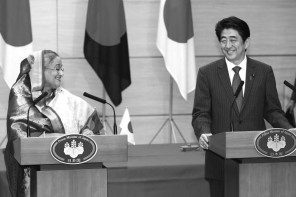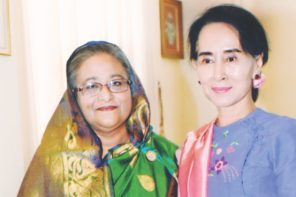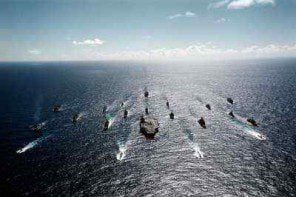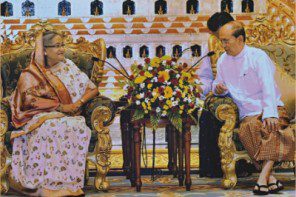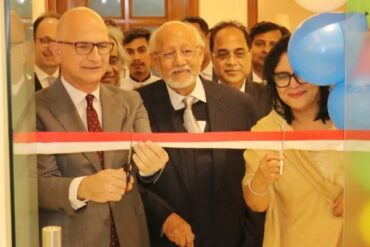India’s Prime Minister Narendra Modi’s visit to Bangladesh has ushered in a new era not only in bilateral relations but in a significant way for the sub-region (Bangladesh, Bhutan, India and Nepal) through the signing of 22 agreements and memorandum of understandings on all possible sectors including multi-modal connectivity. It is a new dawn in the sub-region.
The agreements also will open up the sub-region in an unprecedented scale for investment, trade, people-to people contact which will have multiplier positive effects on the sub-region. Furthermore relations between the two countries have reached a new height which could result Bangladesh, a hub of economic activities in the sub-region. It is reported that the World Bank could lend more than $1 billion to Bangladesh to implement a number of regional connectivity projects for boosting trade and investment among Bangladesh, India, Nepal and Bhutan..
It is good to note the Land Boundary Agreement came into fruition after 41 years removing a humanitarian problem for the inhabitants of the enclaves in both countries. The 1974 Land Agreement stated that the boundaries of Muhuri River, Feni River, Hakar Khal and Baikari Khal would be fixed. .It is not known whether any solution regarding this issue was discussed and agreed upon with India during the visit.
According to some analysts, since most of the benefits will be accrued to India, it would have been desirable for India to have provided one billion or $500 million as a grant to Bangladesh out of $ 2 billion credit suppliers’ loan. For a country with $2 trillion GDP, $500 million or one billion dollar is considered as a “pea nut”. In recent years India had provided to Afghanistan about $ 400 million as a grant.
As regards benefits, however, we should also remember that benefits, tangible or intangible, in each and every case are not comparable and unlikely to be equal and Bangladesh may gain more than India in some areas and reverse may be the case for India.
There have been some disappointments too:
First, although the bilateral relations has gone to a new height with the visit of Prime Minister Modi, it has been perceived to have been greatly diminished by the non-signing of the Teesta Water Sharing Agreement. Bangladesh people expected that Indian Prime Minister with its huge mandate from his people would be able to conclude the Teesta sharing agreement.
It is reported that Prime Minister Modi said “Our rivers should nurture our relationship, not become a source of discord. Water sharing is, above all, a human issue. It affects life and livelihood on both sides of the border” and expressed his confidence that with the support of all stake holders in India, he would be able to reach a consensus over Teesta deal. However, no time is provided by which the agreement of the Teesta River would be concluded.
Some analysts say that Teesta deal would be possible after the legislative elections of West Bengal in 2016 because politically it is not desirable to conclude the deal before the elections in which both BJP and Trinamool Congress will contest.
It is satisfying to note Bangladesh Prime Minister requested her Indian counterpart for immediate conclusion of the interim agreement on sharing of water of Teesta as agreed upon by both the governments in January 2011. It simply means that no amended or revised agreement on sharing of water of Teesta River would be acceptable to Bangladesh.
It is also heartening to note a report in the media that Bangladesh Prime Minister reportedly conveyed this message “very boldly and diplomatically” to her Indian counterpart Narendra Modi for a fair and comprehensive solution to sharing of water not only of the Teesta but of all the 54 common rivers with India.
Second, although the two Prime Ministers noted that discussions relating to sharing waters of the Manu, Muhuri, Gumti, Dharla and Dudkumar rivers were taking place at the technical level under JRC (Joint Rivers Commission) and asked the concerned officials for taking expeditious actions to conclude the sharing arrangements “at the earliest” but no date was provided when the meeting of the concerned officials would take place.
Third, the two Prime Ministers stressed the need for holding the 38th Ministerial meeting of the JRC at an early date to discuss all issues pertinent to water resources but no date was proposed. It remains uncertain when the Ministerial meeting would be held.
Fourth, Prime Minister Modi talked about increasing tourism between the people of the two countries but he did not provide onarrival visa (online visa-e-visa) to India as Bangladesh people expected . However the Indian Prime Minister during his visit in the middle of May reportedly provided online visa facilities for Chinese tourists.
Fifth while Prime Minister Modi has reportedly said: “ People thought we were paas-paas (close to each other) but also saath-saath (together),” and if this is the case, it is does not seem to be consistent with India ‘s fencing off with barbwire of 3,300 kilometres border of Bangladesh which has always been perceived to display the unfriendly sentiment of India towards people of Bangladesh.
Sixth, in the western side of Bangladesh, the adverse effects of Farakka Barrage have practically led to the death of many rivers (100 or more) in Bangladesh, according to water experts. To counter the effects of Farakka Barrage Bangladesh needs to construct the Ganges Barrage inside Bangladesh with Indian support. If the Ganges Barrage is built, the benefits will be huge. According to a report, it is estimated that an additional 2.6 million tones of food grains would be produced and 240,000 tonnes of fish would be available Furthermore the Ganges Barrage would have provided more water to the river near the Rooppur Nuclear Plants, being constructed in Pabna with Russian assistance.
It is reported that when the issue was raised, Indian side stated that the proposal would be examined by the concerned agencies in India. Diplomatically it could mean that the Bangladesh proposal of the Ganges Barrage may not see any fruition in near future.
Seventh, although both sides agreed that Doordarshan ( Indian government TV) and Bangladesh Television (BTV) will enter into agreement to allow to join Prasr Bharti’s DTH platform, at present there is no scope for Bangladesh private TV cable channels to be viewed in India while many private Indian cable channels are being watched in Bangladesh. It would have desirable to facilitate the Bangladesh private cable channels to be aired in India. This would have allowed Indian citizens to be aware especially of various views on India-Bangladesh relations by many analysts in Bangladesh besides what they know in the Indian print and electronic media. Furthermore some concrete steps are necessary to facilitate easy availability of books and daily newspapers in each other countries as it had existed before the 1965 Indo-Pak War.
Despite all these disappointments, we congratulate both the Prime Ministers for the bold vision of new pathway of progress and prosperity to eliminate poverty which is the common enemy for the sub-region as our Prime Minister recently indicated, it is hoped that at the earliest border killing for whatever reasons becomes zero, trade deficit for Bangladesh is drastically reduced and sharing of waters of all common rivers turn out to be a reality.
Furthermore the Hasina government’s friendly policy toward India is vindicated in the eyes of Bangladesh people, and Prime Minister Modi’s visit will not only boost Bangladesh-India relations but also may act as a catalyst for stronger sub-regional architecture through the signing of 22 deals during Indian Prime Minister’s visit.
The writer is the former Ambassador of Bangladesh.


